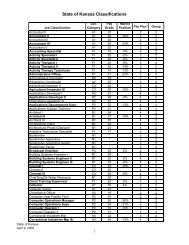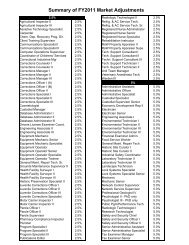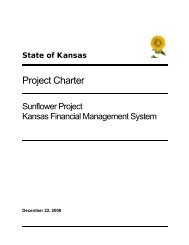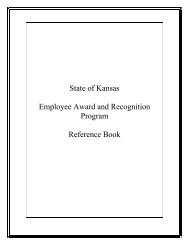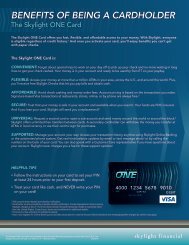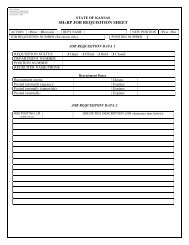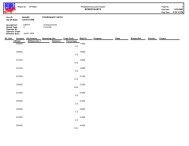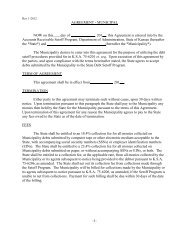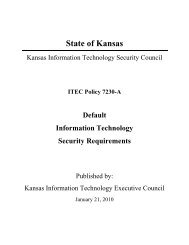Eligibility Qualifying Reasons for FMLA Leave - Department of ...
Eligibility Qualifying Reasons for FMLA Leave - Department of ...
Eligibility Qualifying Reasons for FMLA Leave - Department of ...
You also want an ePaper? Increase the reach of your titles
YUMPU automatically turns print PDFs into web optimized ePapers that Google loves.
FAMILY MEDICAL LEAVE ACT<br />
FAQS<br />
Updated November 2013<br />
Protections<br />
Q: What protections does the <strong>FMLA</strong> provide?<br />
A: Up to 12 weeks job protection in a 12 month period and maintains insurance.<br />
Q: Do I get to keep my same job?<br />
A: Yes. You would be maintained/returned to the same or comparable job. You should experience no<br />
adverse actions due to the use <strong>of</strong> <strong>FMLA</strong>.<br />
<strong>Eligibility</strong><br />
Q: How long does an employee have to work <strong>for</strong> the employer be<strong>for</strong>e they are eligible <strong>for</strong> <strong>FMLA</strong> leave?<br />
A: The employee must have been employed by the employer <strong>for</strong> at least 12 months (does not need to<br />
be consecutive) AND have worked <strong>for</strong> at least 1,250 hours in the immediately preceding 12 months.<br />
Q: If I have to miss work due to National Guard or Reserve duty, will this affect my eligibility <strong>for</strong> <strong>FMLA</strong><br />
leave?<br />
A: No. The regulations make clear the protections <strong>for</strong> our men and women serving in the military by<br />
stating that a break in service due to an employee’s fulfillment <strong>of</strong> military obligations must be taken into<br />
consideration when determining whether an employee has been employed <strong>for</strong> 12 months or has the<br />
required 1,250 hours <strong>of</strong> service. Under USERRA (Uni<strong>for</strong>med Services Employment and Reemployment<br />
Rights Act or 1994), hours that an employee would have worked, but <strong>for</strong> his or her military service, are<br />
credited toward the employee’s required 1,250 hours worked <strong>for</strong> <strong>FMLA</strong> eligibility. Similarly, the time in<br />
military service also must be counted in determining whether the employee has been employed at least<br />
12 months by the employer.<br />
Q: Are student employees covered under the <strong>FMLA</strong>?<br />
A: If they are being paid they are covered. However, they may not meet the 12 month/1,250 hour<br />
requirement. If they meet the eligibility requirements they would be covered.<br />
Q: Are both Classified and Unclassified employees covered?<br />
A: Yes, if the meet the eligibility requirements.<br />
<strong>Qualifying</strong> <strong>Reasons</strong> <strong>for</strong> <strong>FMLA</strong> <strong>Leave</strong><br />
Q: What qualifies <strong>for</strong> <strong>FMLA</strong> protection?<br />
A: (1) Birth <strong>of</strong> child and care <strong>for</strong> the newborn child;<br />
(2) Placement with the employee <strong>of</strong> a child <strong>for</strong> adoption or foster care;<br />
(3) Care <strong>for</strong> the employee’s spouse, child, or parent with a serious health condition;<br />
(4) Employee’s serious health condition that makes the employee unable to per<strong>for</strong>m the essential<br />
functions <strong>of</strong> the employee’s job;
(5) <strong>Qualifying</strong> exigency arising out <strong>of</strong> the fact that the employee’s spouse, child, or parent is a<br />
covered military member on active duty, or has been notified <strong>of</strong> an impending call or order<br />
to active duty;<br />
(6) Care <strong>for</strong> a covered service member or veteran with a serious injury or illness incurred through<br />
the line <strong>of</strong> duty, if the employee is the spouse, child, parent, or next <strong>of</strong> kin <strong>of</strong> the service<br />
member.<br />
Q: Can I use <strong>FMLA</strong> leave during pregnancy or after the birth <strong>of</strong> a child?<br />
A: Yes. Under the regulations, a mother can use a total <strong>of</strong> 12 weeks <strong>of</strong> <strong>FMLA</strong> leave <strong>for</strong> the birth <strong>of</strong> a<br />
child, <strong>for</strong> prenatal care, <strong>for</strong> incapacity related to pregnancy, <strong>for</strong> her own serious health condition<br />
following the birth <strong>of</strong> a child, or a combination <strong>of</strong> these factors. A father can use 12 weeks <strong>of</strong> <strong>FMLA</strong><br />
leave <strong>for</strong> the birth <strong>of</strong> a child and/or care <strong>for</strong> his SPOUSE, who is incapacitated due to the pregnancy or<br />
child birth.<br />
Q: Can the mother and father each use 12 weeks <strong>of</strong> <strong>FMLA</strong> leave <strong>for</strong> the birth <strong>of</strong> a child?<br />
A: Yes. The law states that the 12 weeks <strong>FMLA</strong> leave may be the combined leave <strong>for</strong> both mother and<br />
father. However, if mother and father are both State <strong>of</strong> Kansas employees the state has determined<br />
that both mother and father would be allowed 12 weeks <strong>of</strong> <strong>FMLA</strong> leave <strong>for</strong> bonding with the new child.<br />
Q: What is a “serious health condition”?<br />
A: A “serious health condition” is defined as an illness, injury, impairment, or physical or mental<br />
condition that involves inpatient care or continuing treatment by a health care provider. The “continuing<br />
treatment” means: (1) a period <strong>of</strong> incapacity <strong>of</strong> more than 3 consecutive, full calendar days plus<br />
treatment by a health care provider twice, or once with a continuing regimen <strong>of</strong> treatment; (2) any<br />
period <strong>of</strong> incapacity related to pregnancy or prenatal care; (3) any period <strong>of</strong> incapacity or treatment <strong>of</strong> a<br />
chronic serious health condition; (4) a period <strong>of</strong> incapacity <strong>for</strong> permanent or long‐term conditions <strong>for</strong><br />
which treatment may not be effective; or (5) any period <strong>of</strong> incapacity to receive multiple treatments<br />
(including recovery from those treatments) <strong>for</strong> restorative surgery, or <strong>for</strong> a condition which would likely<br />
result in an incapacity <strong>of</strong> more than 3 consecutive, full calendar days.<br />
Q: Are chronic serious health conditions covered?<br />
A: Yes. The regulations define a chronic serious health condition as one that<br />
(1) Requires “periodic visits” <strong>for</strong> treatment by a health care provider or nurse under the<br />
supervision <strong>of</strong> the health care provider (The regulations define “periodic visits” as at least<br />
twice a year);<br />
(2) Continues over an extended period <strong>of</strong> time; AND<br />
(3) May cause episodic rather than continuing periods <strong>of</strong> incapacity.<br />
Q: Who is considered a child?<br />
A: For the purposes <strong>of</strong> <strong>FMLA</strong>, a child means a biological, adopted, or foster child, a stepchild, a legal<br />
ward, or a child <strong>of</strong> a person standing in loco parentis, who is either under the age <strong>of</strong> 18 or age 18 or<br />
older and incapable <strong>of</strong> self‐care because <strong>of</strong> a mental or physical disability in accordance with the ADA, at<br />
the time the <strong>FMLA</strong> leave is to commence.<br />
Q: What qualifies as “loco parentis”?<br />
A: The <strong>FMLA</strong> interprets “loco parentis” very broadly. The employee would not have to have <strong>of</strong>ficial,<br />
legal documents to establish “loco parentis”. The employee would have to establish that the child is
living in their household. Examples could include: grandparents raising their grandchild; same sex<br />
partner being responsible <strong>for</strong> the adopted child; stepparents.<br />
Q: If a wife’s father becomes ill and needs care that is covered under the <strong>FMLA</strong>, can the husband take<br />
<strong>FMLA</strong> to help take care <strong>of</strong> his father‐in‐law?<br />
A: No. The law applies only to direct family members, parent, spouse, child, not in‐laws.<br />
Q: Can an employee have <strong>FMLA</strong> coverage <strong>for</strong> multiple claims <strong>for</strong> different qualifying events?<br />
A: Yes. An employee is allowed 12 weeks <strong>of</strong> <strong>FMLA</strong> protected leave in a 12 month time period. An<br />
employee could be covered <strong>for</strong> multiple claims as long as the total <strong>FMLA</strong> coverage does not exceed 12<br />
weeks in a 12 month period and the employee has worked 1250 hours in the preceding 12 months <strong>of</strong><br />
the request.<br />
Q: How is the 12 month time period determined?<br />
A: In the State <strong>of</strong> Kansas, the 12 months begins the day <strong>FMLA</strong> leave is first taken. At the end <strong>of</strong> those 12<br />
months, regardless <strong>of</strong> how many hours were used, the <strong>FMLA</strong> coverage period ends. The employee<br />
would have to go through the Certification process again and meet the 1250 hours worked, if they feel<br />
they may continue to have a qualifying issue, or there would be a new qualifying event.<br />
Q: Are “eligibility” and “qualifying” the same thing?<br />
A: No. An employee must first meet the eligibility requirements <strong>of</strong> working <strong>for</strong> the employer <strong>for</strong> at least<br />
12 months and have worked <strong>for</strong> 1,250 hours in the past 12 months be<strong>for</strong>e Certification would be<br />
request to determine qualification. “Qualification” means the employee meets one <strong>of</strong> the medical or<br />
military requirements <strong>for</strong> <strong>FMLA</strong> coverage.<br />
Employer Notification<br />
Q: Must an employer provide general in<strong>for</strong>mation about <strong>FMLA</strong> to their employees?<br />
A: Yes. Employers must post a general notice explaining the <strong>FMLA</strong>’s provisions and providing<br />
in<strong>for</strong>mation regarding procedures <strong>for</strong> filing a claim under the Act in a conspicuous place where it can be<br />
seen by employees and applicants.<br />
Q: How soon after an employee provides notice <strong>of</strong> the need <strong>for</strong> leave must an employer determine<br />
whether someone is eligible <strong>for</strong> <strong>FMLA</strong> leave?<br />
A: Absent extenuating circumstances, the regulations require an employer to notify an employee <strong>of</strong><br />
whether the employee is eligible to take <strong>FMLA</strong> leave (and, if not, at least one reason why the employee<br />
is ineligible) within 5 business days <strong>of</strong> the employee requesting leave or the employer learning that an<br />
employee’s leave could be <strong>FMLA</strong>. Once the required certification is received the employer also has 5<br />
business days to notify the employee if the situation qualifies <strong>for</strong> <strong>FMLA</strong> coverage.<br />
Q: Does an employer have to provide employees with in<strong>for</strong>mation regarding their specific rights and<br />
responsibilities under the <strong>FMLA</strong>?<br />
A: Yes. At the same time an employer provides an employee notice <strong>of</strong> the employee’s eligibility to take<br />
<strong>FMLA</strong> leave, the employer must also notify the employee <strong>of</strong> the specific expectations and obligations<br />
associated with the leave. Among other in<strong>for</strong>mation included in this notice, the employer must in<strong>for</strong>m<br />
the employee that they will be required to provide certification or the <strong>FMLA</strong> qualifying reason <strong>for</strong> leave<br />
and that the employee will be required to use their paid leave during <strong>FMLA</strong> absences unless no leave is
available, then the <strong>FMLA</strong> leave will be unpaid. Employers are expected to responsively answer questions<br />
from employees concerning their rights and responsibilities.<br />
Q: How soon after an employee provides notice <strong>of</strong> the need <strong>for</strong> leave must an employer notify an<br />
employee that the leave will be designated and counted as <strong>FMLA</strong> leave?<br />
A: Under the regulations, an employer must provide an employee with the certification and in<strong>for</strong>mation<br />
on <strong>FMLA</strong> within 5 business days <strong>of</strong> learning that the leave is being taken could be <strong>for</strong> an <strong>FMLA</strong> qualifying<br />
reason, absent extenuating circumstances. The designation notice must also state whether paid leave<br />
will be substituted <strong>for</strong> unpaid <strong>FMLA</strong> leave and whether the employer will require the employee to<br />
provide a fitness‐<strong>for</strong>‐duty certification in order to return to work. Once the employee returns the<br />
completed certification, the employer has 5 business days to notify the employee if the leave will be<br />
covered by <strong>FMLA</strong>.<br />
Q: If an employer fails to tell an employee that leave has been designated as <strong>FMLA</strong> leave, can the<br />
employer count the leave against the employee’s <strong>FMLA</strong> leave entitlement?<br />
A: Under the regulations, retroactive designation is permitted if an employer fails to timely designate<br />
leave as <strong>FMLA</strong> leave but the employer must notify the employee <strong>of</strong> the designation. Caution: The<br />
employer may be liable if the employee can show that he or she has suffered harm or injury as a result<br />
<strong>of</strong> the failure to timely designate the leave as <strong>FMLA</strong>. Additionally, an employee and employer may agree<br />
to retroactively designate an absence as <strong>FMLA</strong> protected.<br />
Employee Notice Requirements<br />
Q: How much notice must an employee give be<strong>for</strong>e taking <strong>FMLA</strong> leave?<br />
A: When the need <strong>for</strong> leave is <strong>for</strong>eseeable based on an expected birth, placement <strong>for</strong> adoption or foster<br />
care, or planned medical treatment, an employee must give at least 30 days’ notice. If 30 days’ notice is<br />
not possible, an employee is required to provide notice “as soon as practicable”. Employees must also<br />
provide notice as soon as practicable <strong>for</strong> <strong>for</strong>eseeable leave due to a qualifying exigency, regardless <strong>of</strong><br />
how far in advance such leave is <strong>for</strong>eseeable either the same day or the next business day upon<br />
receiving notice. In all cases, however, the determination <strong>of</strong> when an employee could practicably<br />
provide notice must account <strong>for</strong> the individual facts and circumstances.<br />
When the leave is un<strong>for</strong>eseeable, employees are required to provide notice as soon as practicable under<br />
the facts and circumstances <strong>of</strong> the particular case, which the regulations clarify will generally be within<br />
the time prescribed by the employer’s usual and customary notice requirements applicable to the leave.<br />
Q: What in<strong>for</strong>mation must an employee give when providing notice <strong>of</strong> the need <strong>for</strong> <strong>FMLA</strong> leave?<br />
A: When an employee seeks leave <strong>for</strong> the first time <strong>for</strong> an <strong>FMLA</strong> qualifying reason, the employee does<br />
not need to specifically assert his or her rights under <strong>FMLA</strong>, or even mention <strong>FMLA</strong>. The employee must,<br />
however, provide “sufficient in<strong>for</strong>mation” to make the employer aware <strong>of</strong> the need <strong>for</strong> <strong>FMLA</strong> leave and<br />
the anticipated timing and duration <strong>of</strong> the leave. (“Sufficient in<strong>for</strong>mation” needs to be provided on the<br />
Federal Certification Form.) Depending on the situation, “sufficient in<strong>for</strong>mation” may include<br />
in<strong>for</strong>mation that a condition renders the employee unable to per<strong>for</strong>m the essential functions <strong>of</strong> the job;<br />
that the employee is pregnant or has been hospitalized overnight; whether the employee or the<br />
employee’s family member is under the continuing care <strong>of</strong> a health care provider; if the leave is due to a<br />
qualifying exigency, that a covered military member is being deployed <strong>for</strong> active duty or a family<br />
member that is on active duty or a veteran needs care <strong>for</strong> a serious illness or injury due to do military
service; if the leave is to care <strong>for</strong> a family member unable to per<strong>for</strong>m daily life activities; and the<br />
duration <strong>of</strong> the absence if known.<br />
Q: Is an employee required to follow an employer’s normal call‐in procedures when taking <strong>FMLA</strong> leave?<br />
A: Yes. If the employee is on intermittent <strong>FMLA</strong> leave, the employee must comply with an employer’s<br />
call‐in/<strong>of</strong>f procedures unless unusual circumstances prevent the employee from doing so (in which case<br />
the employee must provide notice as soon as he or she can practicably do so). The regulations make it<br />
clear that, if an employee fails to provide timely notice, he or she may have the <strong>FMLA</strong> leave request<br />
delayed or denied and may be subject to whatever discipline the employer’s policies and practices<br />
provide.<br />
If an employee is on <strong>FMLA</strong> leave <strong>for</strong> a block <strong>of</strong> time, the employee does not have to call in every day.<br />
<strong>FMLA</strong> Certification<br />
Q: Do I have to give my employer my medical records <strong>for</strong> leave when I am asking <strong>for</strong> <strong>FMLA</strong> leave?<br />
A: No. An employee is not required to give the employer his or her medical records. HOWEVER, the<br />
employer does have a statutory right to request that an employee provide a completed Certification<br />
from a Health Care Provider that provides sufficient medical facts to establish that a serious health<br />
condition exists. The State <strong>of</strong> Kansas uses the Federal Certification <strong>for</strong>ms <strong>for</strong> Health Care Providers to<br />
determine if <strong>FMLA</strong> qualification is met.<br />
Q: How soon after I request <strong>FMLA</strong> leave does my employer have to request a medical certification <strong>of</strong> a<br />
serious health condition?<br />
A: Under the regulations, an employer should request medical certification, in most cases, at the time<br />
an employee gives notice <strong>of</strong> the need <strong>for</strong> leave or within 5 business days. If the leave is un<strong>for</strong>eseen, the<br />
employer should request medical certification within 5 days after the employer is aware <strong>of</strong> a possible<br />
need <strong>for</strong> <strong>FMLA</strong>.<br />
Q: Are there specific certification <strong>for</strong>ms that must be used?<br />
A: Yes. State agencies should use the US <strong>Department</strong> <strong>of</strong> Labor <strong>FMLA</strong> <strong>for</strong>ms. A list <strong>of</strong> those <strong>for</strong>ms may be<br />
found in DPS Bulletin No. 09‐03; on the Division <strong>of</strong> Personnel Services Website,<br />
http://da.ks.gov/ps/subject/fmla.htm, and at the USDOL website:<br />
http://www.dol.gov/esa/shd/fmla/finalrule.htm.<br />
Q: How long does the employee have to return the completed certification?<br />
A: Under normal circumstances, the employee will have 15 calendar days to return the completed<br />
certification. If there are extenuating circumstances that would prevent the return <strong>of</strong> the completed<br />
certification in that time frame, the employee should consult with the employer about the reasons.<br />
Q: What happens if the employee does not provide the employer with the certification within the 15<br />
days?<br />
A: The employer should contact the employee in writing stating the certifications had not been received<br />
within the 15 days and give the employee 7 more calendar days to provide the certification. If the<br />
employee does not provide the certification, the employer can deny that specific request and the<br />
employee would not have <strong>FMLA</strong> protection dating back from the date <strong>of</strong> the first absence due to the<br />
<strong>FMLA</strong> request.
Q: What if an employee makes a subsequent request <strong>for</strong> <strong>FMLA</strong> after being denied <strong>FMLA</strong> coverage <strong>for</strong><br />
untimeliness or failure to provide certification?<br />
A: If the employee makes a subsequent request (even <strong>for</strong> the same medical issue), the employer should<br />
take the same notification steps as if it were a new request. If the employee provides the completed<br />
certification within the 15 day time period and the in<strong>for</strong>mation establishes a medical condition that<br />
meets the <strong>FMLA</strong> requirements, <strong>FMLA</strong> would be granted <strong>for</strong>ward from the date <strong>of</strong> the second request.<br />
Q: What happens if my employer says my medical certification in incomplete?<br />
A: An employer must advise the employee if it finds the certification is incomplete and allow the<br />
employee a reasonable opportunity to cure the deficiency. The regulations require that the employer<br />
state in writing what additional in<strong>for</strong>mation is necessary to make the certification complete and<br />
sufficient. The regulations also require that the employer allow the employee at least 7 calendar days to<br />
cure the deficiency, unless 7 days is not practicable under the particular circumstances despite the<br />
employee’s diligent good faith ef<strong>for</strong>ts.<br />
Q: May my employer contact my health care provider about my medical in<strong>for</strong>mation?<br />
A: The regulations clarify that contact between an employer and an employee’s health care provider<br />
must comply with HIPPA privacy regulations. Contact with the employee’s health care provider should<br />
only be made by the human resource pr<strong>of</strong>essional or leave administrator who is responsible <strong>for</strong><br />
managing the <strong>FMLA</strong>. Under no circumstances should the employee’s direct supervisor contact the<br />
employee’s health care provider. The employee may need to provide their health care provider with a<br />
written authorization allowing the health care provider to disclose such in<strong>for</strong>mation to the employer.<br />
Employers can only ask clarifying in<strong>for</strong>mation and questions related to the specific questions on the<br />
certification and may not ask <strong>for</strong> in<strong>for</strong>mation beyond what would be provided on the certification.<br />
Q: Must the employee sign a medical release as part <strong>of</strong> the medical certification?<br />
A: No. An employer may not require an employee to sign a release or waiver as part <strong>of</strong> the medical<br />
certification process. The regulations specifically state that completing any such authorization is at the<br />
employee’s discretion. Whenever an employer requests a medical certification, however, it is the<br />
employee’s responsibility to provide the employer with a complete and sufficient certification. If an<br />
employee does not provide either a complete and sufficient certification or an authorization allowing<br />
the health care provider to provide complete and sufficient in<strong>for</strong>mation to the employer, the<br />
employee’s request <strong>for</strong> <strong>FMLA</strong> leave may be denied.<br />
Q: How <strong>of</strong>ten may my employer ask <strong>for</strong> medical certifications <strong>for</strong> an on‐going serious health condition?<br />
A: The regulations allow recertification no more <strong>of</strong>ten than every 30 days in connection with an absence<br />
by the employee, unless the condition will last <strong>for</strong> more than 30 days. For conditions that are certified<br />
as having a minimum duration <strong>of</strong> more than 30 days, the employer must wait to request recertification<br />
until the specified period has passed, except that in all cases the employer may request recertification<br />
every 6 months in connection with an absence by the employee. The regulations also allow an employer<br />
to request recertification in less than 30 days if the employee requests an extension <strong>of</strong> leave, the<br />
circumstances described in the previous certification have changed significantly, or if the employer<br />
receives in<strong>for</strong>mation that casts doubt upon the employee’s stated reason <strong>for</strong> the absence or the<br />
continuing validity <strong>of</strong> the certification.<br />
Q: Can employers require employees to submit a fitness‐<strong>for</strong>‐duty certification be<strong>for</strong>e returning to work<br />
after being absent due to a serious health condition?
A: Yes. As a condition <strong>of</strong> restoring an employee who was absent on <strong>FMLA</strong> leave due to the employee’s<br />
own serious health condition, an employer may have a uni<strong>for</strong>mly applied policy or practice that requires<br />
all similarly situated employees who take leave <strong>for</strong> such conditions to submit a certification from the<br />
employee’s own health care provider that the employee is able to resume work. Under the regulations,<br />
an employer may require that the fitness‐<strong>for</strong>‐duty certification address the employee’s ability to<br />
per<strong>for</strong>m the essential functions <strong>of</strong> the position if the employer has appropriately notified the employee<br />
that this in<strong>for</strong>mation will be required and has provided a list <strong>of</strong> the essential functions. Additionally, the<br />
employer may require a fitness‐<strong>for</strong>‐duty certification up to once every 30 days <strong>for</strong> an employee taking<br />
intermittent or reduced schedule <strong>FMLA</strong> leave if reasonable safety concerns exist regarding the<br />
employee’s ability to per<strong>for</strong>m his or her duties based on the condition <strong>for</strong> which leave was taken.<br />
Q: What happens if you do not submit a requested fitness‐<strong>for</strong>‐duty certification?<br />
A: If an employee fails to timely submit a properly requested fitness‐<strong>for</strong>‐duty certification, the employer<br />
may delay job restoration until the employee provides the certification. If the employee never provides<br />
the certification, he or she may be denied reinstatement.<br />
Q: Can an employee request <strong>FMLA</strong> certification “just in case” they may have a medical situation arise<br />
from a chronic condition, be<strong>for</strong>e there is a specific absence?<br />
A: An employee should only request <strong>FMLA</strong> certification when there is an actual medical situation. A<br />
chronic condition requires at least 2 Dr visits in a 12 month period <strong>for</strong> the specific condition.<br />
Military Coverage<br />
Q: Who is eligible <strong>for</strong> coverage under the Military components <strong>of</strong> the <strong>FMLA</strong>?<br />
A: In order <strong>for</strong> employees to be eligible <strong>for</strong> <strong>FMLA</strong> leave <strong>for</strong> the military components, the employee must<br />
meet the same eligibility criteria as <strong>for</strong> other <strong>FMLA</strong> leave. The employee must have worked <strong>for</strong> the<br />
employer <strong>for</strong> at least 12 months (non‐consecutive) and have worked at least 1,250 hours in the<br />
preceding 12 months.<br />
Q: What types <strong>of</strong> military <strong>FMLA</strong> leave are there?<br />
A: There are two types <strong>of</strong> military <strong>FMLA</strong> leave. 1) Exigency <strong>Leave</strong>; 2) Care giver leave.<br />
1) <strong>Qualifying</strong> Exigency: an eligible employee is entitled to up to 12 weeks <strong>for</strong> any qualifying<br />
exigency, arising out <strong>of</strong> the fact that the spouse, child, or parent <strong>of</strong> the employee is on active<br />
duty in a <strong>for</strong>eign country or has been notified <strong>of</strong> an impending call to active duty status in a<br />
<strong>for</strong>eign country, in support <strong>of</strong> a contingency operation. This applies to members <strong>of</strong> the<br />
Regular Armed Forces, National Guard or Reserves.<br />
2) Care giver leave: an eligible employee who is the spouse, child, parent, or identified next <strong>of</strong><br />
kin <strong>of</strong> a covered service member who is recovering from a serious illness or injury sustained<br />
in the line <strong>of</strong> duty while on active duty in a <strong>for</strong>eign country, is entitled to up to 26 weeks <strong>of</strong><br />
leave in a single 12 month period to care <strong>for</strong> the service member. This applies to members<br />
<strong>of</strong> the Regular Armed Forces, National Guard, Reserves, and certain Veterans. (Eligible<br />
veterans are those that are undergoing medical treatment <strong>for</strong> an injury or illness sustained<br />
or aggravated during active military service within 5 years <strong>of</strong> the date on which the veteran<br />
undergoes medical treatment).<br />
Q: Could an employee have both exigency leave and care giver leave in the same year?<br />
A: Yes. It is possible that an employee could have both exigency and care giver leave in the same 12<br />
month time period. The total amount <strong>of</strong> time allowed would be 26 weeks. Example: If 20 weeks were
used <strong>for</strong> care giver leave, the employee would only have 6 weeks remaining <strong>for</strong> exigency leave or other<br />
<strong>FMLA</strong> leave. Under no circumstances can the employee use more than 26 week total and no more<br />
than 12 weeks <strong>for</strong> event other than military care giving.<br />
Q: What are considered qualifying exigencies?<br />
A: Issues that arise from the fact that a covered military member is notified <strong>of</strong> an impending call or<br />
order to active duty in a <strong>for</strong>eign country or due to current service in a <strong>for</strong>eign country. This can include<br />
military events, child care, family support activities, legal issues, school issues. For details <strong>of</strong> qualifying<br />
exigencies see 29 CFR Part 825.126.<br />
Miscellaneous<br />
Q: If an employee is on <strong>FMLA</strong> leave, leave without pay, <strong>for</strong> more than 30 days – does this affect their<br />
length <strong>of</strong> service?<br />
A: No. An employee cannot be harmed or lose employment benefits while on approved <strong>FMLA</strong> leave.<br />
There<strong>for</strong>e, if an employee is on <strong>FMLA</strong> without pay <strong>for</strong> more than 30 days, their length <strong>of</strong> service is not<br />
interrupted.<br />
Q: Does “light duty” count towards the 12 weeks <strong>of</strong> <strong>FMLA</strong> protection?<br />
A: No. “Light duty” does not count against the employee’s <strong>FMLA</strong> leave entitlement. The employee’s<br />
right to job restoration is also retained during the light‐duty period, but only until the end <strong>of</strong> the 12<br />
month period that the employer uses to calculate the <strong>FMLA</strong> leave.<br />
Q: Who qualifies as a “medical provider”?<br />
A: As long as the insurance carrier recognizes and pays <strong>for</strong> treatment provided by the “medical<br />
provider”, that provider would be considered a “medical provider” <strong>for</strong> <strong>FMLA</strong> purposes.<br />
Q: If <strong>FMLA</strong> leave prevents the employee from working mandatory overtime are those hours counted<br />
toward the 12 weeks <strong>of</strong> <strong>FMLA</strong> protection?<br />
A: If an employee has a job requiring mandatory overtime (even if not regularly scheduled) and the<br />
employee has a qualifying approved <strong>FMLA</strong> event, ALL time absent from work, including mandatory<br />
overtime, due to the <strong>FMLA</strong> coverage would be counted toward the 12 weeks <strong>of</strong> <strong>FMLA</strong>.<br />
Q: If a state employee is on an approved <strong>FMLA</strong> and transfers to another state agency, what happens to<br />
the <strong>FMLA</strong>?<br />
A: If a state employee is on an approve <strong>FMLA</strong> and transfers to another state agency, the <strong>FMLA</strong> coverage<br />
would remain in place.<br />
Q: How would the receiving agency know an employee was on <strong>FMLA</strong>? Isn’t medical in<strong>for</strong>mation<br />
confidential?<br />
A: Yes, medical in<strong>for</strong>mation is confidential. For purposes <strong>of</strong> <strong>FMLA</strong>, state agencies are seen as one<br />
employer – the State. There<strong>for</strong>e, an employee’s <strong>FMLA</strong> entitlement would be preserved from agency to<br />
agency. Just as the employee personnel file transfers with the employee, the employee’s <strong>FMLA</strong> and<br />
medical files would also transfer and be maintained in confidential files at the new agency.



